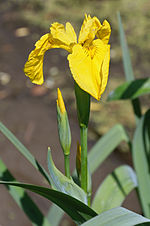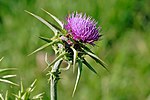Nectar guides are markings or patterns seen in flowers of some angiosperm species, that guide pollinators to their rewards. Rewards commonly take the...
4 KB (426 words) - 19:50, 27 March 2023
Hummingbird (section Perception of sweet nectar)
Noted for long beaks, hummingbirds are specialized for feeding on flower nectar, but all species also consume small insects. They are known as hummingbirds...
165 KB (17,654 words) - 01:52, 4 November 2024
A Bellini is a cocktail made with Prosecco and peach purée or nectar. It originated in Venice, Italy. The Bellini was invented sometime between 1934 and...
6 KB (567 words) - 15:30, 19 August 2024
feed on nectar, using their long hairy tongues to lap up the liquid; the proboscis is folded under the head during flight. Bumblebees gather nectar to add...
108 KB (11,622 words) - 04:45, 2 November 2024
Caribbean. It is the smallest known bird. The bee hummingbird feeds on nectar of flowers and bugs found in Cuba. The bee hummingbird is the smallest living...
16 KB (1,439 words) - 17:12, 6 November 2024
Iris pseudacorus (section Nectar production)
foetidissima (stinking iris). The plant was rated in second place for per day nectar production per flower in a UK plants survey conducted by the AgriLand project...
11 KB (988 words) - 19:07, 20 October 2024
Conservation Practitioner's Guide". The Xerces Society. Retrieved 27 August 2018. "Which flowers are the best source of nectar?". Conservation Grade. 15...
27 KB (2,882 words) - 03:14, 6 August 2024
gathering and then refining the sugary secretions of plants (primarily floral nectar) or the secretions of other insects, like the honeydew of aphids. This refinement...
121 KB (13,066 words) - 00:30, 8 November 2024
Taraxacum (redirect from Dent-de-Lion)
a generalist species, dandelions are one of the most vital early spring nectar sources for a wide host of pollinators. Many Taraxacum species produce seeds...
49 KB (4,645 words) - 03:22, 25 October 2024
Bat (section Fruit and nectar)
insectivores, and most of the rest are frugivores (fruit-eaters) or nectarivores (nectar-eaters). A few species feed on animals other than insects; for example,...
171 KB (18,309 words) - 04:18, 2 November 2024
species is named for its similarity to hummingbirds, as they feed on the nectar of tube-shaped flowers using their long proboscis while hovering in the...
18 KB (1,907 words) - 15:26, 23 October 2024
adapted to gathering pollen and nectar from flowers. Nectar from eucalyptus is important in Australia, other important nectar sources are Pittosporum, Grevillea...
22 KB (2,257 words) - 20:41, 18 August 2024
Hoverfly (section Identification guides)
suggests, they are often seen hovering or nectaring at flowers; the adults of many species feed mainly on nectar and pollen, while the larvae (maggots) eat...
25 KB (2,719 words) - 17:21, 5 November 2024
Euphorbia (category CS1 German-language sources (de))
have sepals, petals, or nectar to attract pollinators, although other nonflower parts of the plant have an appearance and nectar glands with similar roles...
37 KB (3,462 words) - 05:20, 5 August 2024
flowers. Some flowers have patterns, called nectar guides, that show pollinators where to look for nectar; they may be visible only under ultraviolet...
103 KB (11,623 words) - 12:22, 8 November 2024
October 2022. "Hierbas - Nectar of the Gods". Affordable Mallorca. Retrieved 12 October 2022. "Hierbas". www.majorca-guides.info. Retrieved 12 October...
4 KB (361 words) - 15:34, 25 October 2024
are much smaller than drones or queen bees, with bodies specialized for nectar and pollen collection. They perform different tasks around the hive progressively...
21 KB (2,601 words) - 20:34, 3 November 2024
Mosquito (category CS1 German-language sources (de))
specialized, highly elongated, piercing-sucking mouthparts. All mosquitoes drink nectar from flowers; females of some species have in addition adapted to drink...
93 KB (9,294 words) - 01:04, 5 November 2024
Pteropodidae. Despite its scientific name, it feeds exclusively on fruits, nectar, and flowers, like the other flying foxes of the genus Pteropus. It is noted...
21 KB (2,225 words) - 20:38, 16 October 2024
rather a result of the paucity of nectar sources in late summer in urban areas. The evidence against a toxin in the nectar being responsible for mass bee...
7 KB (747 words) - 10:29, 7 November 2024
whose females can attain a length of 39 millimetres (1.54 in). Bees feed on nectar and pollen, the former primarily as an energy source and the latter primarily...
119 KB (12,339 words) - 08:33, 9 November 2024
butterflies by planting milkweed and other nectar-rich plants on private lands. The NRCS also provides region-specific guides and plant lists that support populations...
218 KB (21,356 words) - 23:47, 4 November 2024
system for avian nectar-robbery studies". Scientific Reports. 12 (1). doi:10.1038/s41598-022-16237-9. PMC 9279294. Art. No. 11936. "Field Guide: Sphinx Moths...
11 KB (1,076 words) - 16:08, 11 August 2024
political science. In some later versions, he is said to have possessed the nectar of immortality, which was stored inside his belly thanks to a celestial...
33 KB (3,285 words) - 14:58, 18 October 2024
sugar, or cream. 31 drinks: Bellini Made with Prosecco and peach purée or nectar. Black Russian Made with vodka and coffee liqueur. Bloody Mary Made with...
35 KB (3,621 words) - 06:52, 17 October 2024
Kākā (section Honeydew and Nectar-feeding)
feeds on nectar, and it uses its strong beak to dig out the grubs of the huhu beetle and to remove bark to feed on sap. They consume nectar from plant...
46 KB (5,213 words) - 21:58, 6 November 2024
NATO phonetic alphabet (category CS1 German-language sources (de))
Baker" alphabet. Confusion among words like Delta and Extra, and between Nectar and Victor, or the poor intelligibility of other words during poor receiving...
72 KB (4,951 words) - 11:18, 30 October 2024
milkweed and violets, respectively. As adults, butterflies feed mainly on nectar, but they have also evolved to consume rotting fruit, tree sap, and even...
95 KB (8,816 words) - 20:03, 26 October 2024
flowerheads called panicles. They produce copious amounts of pollen and nectar that are attractive to insects. The winged seeds or samaras are borne in...
50 KB (5,190 words) - 09:31, 1 November 2024
leaves have a mild lemon scent. During summer, small white flowers full of nectar appear. It is not to be confused with bee balm (genus Monarda), although...
17 KB (1,695 words) - 12:36, 5 November 2024





























